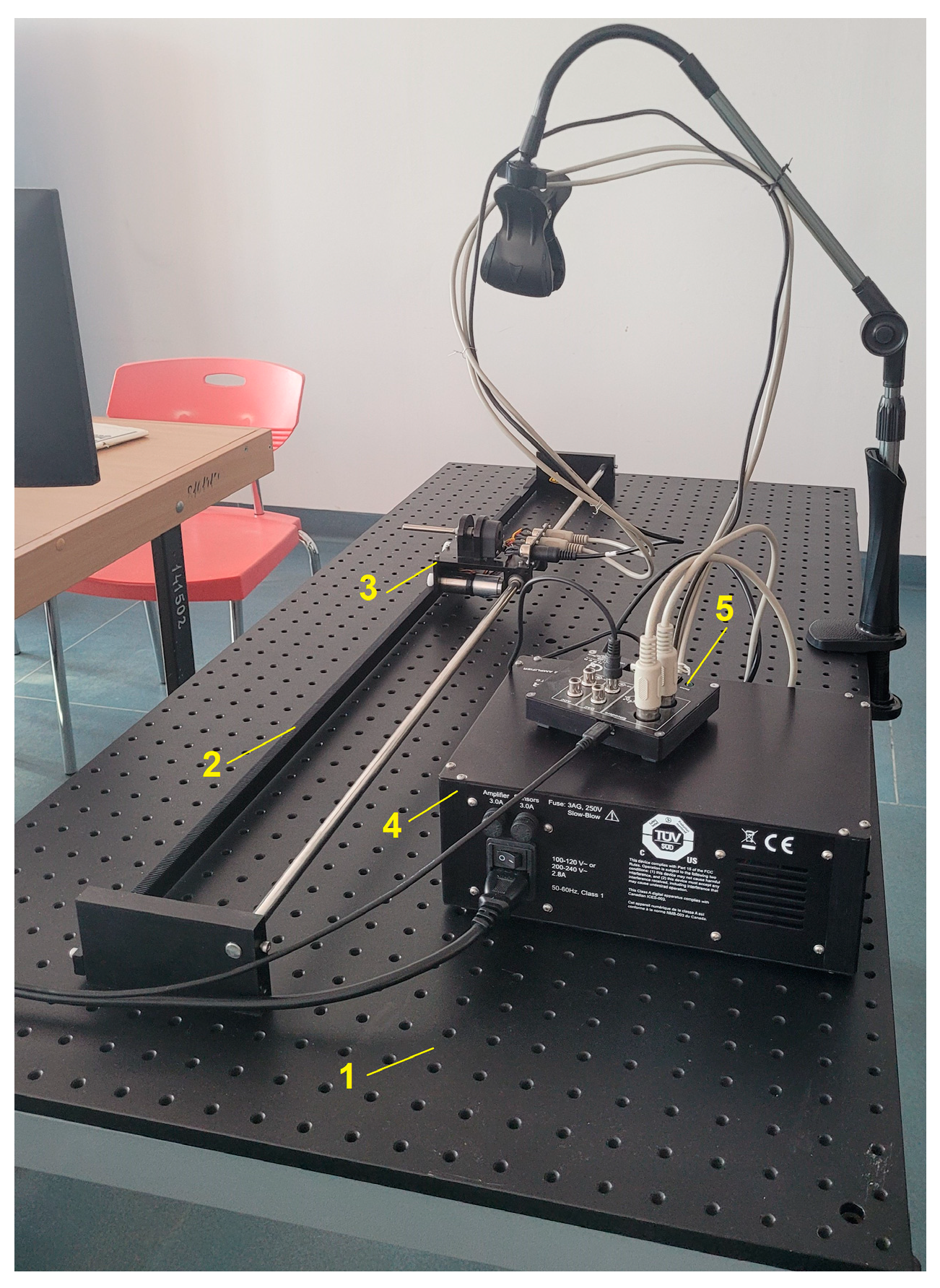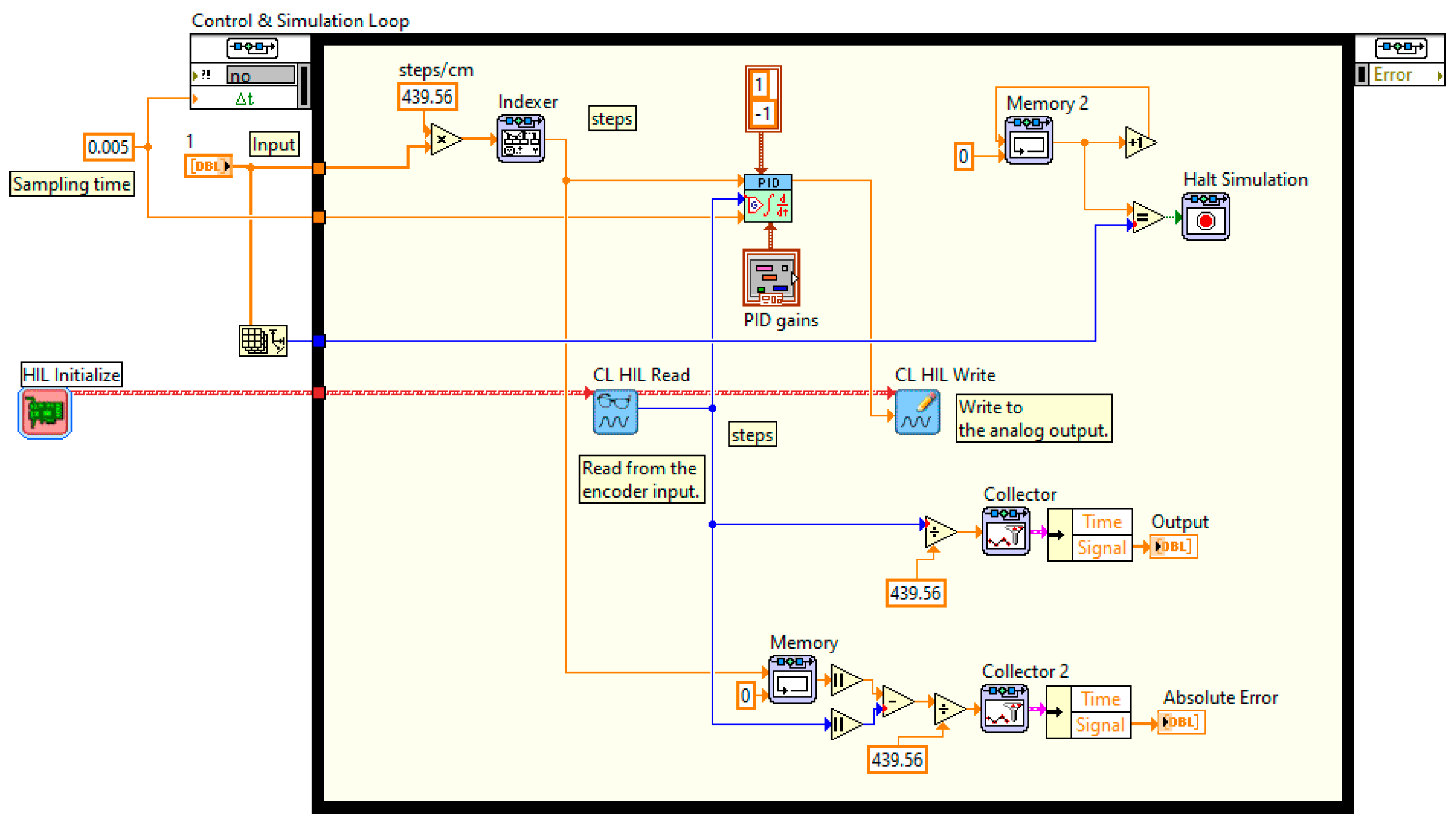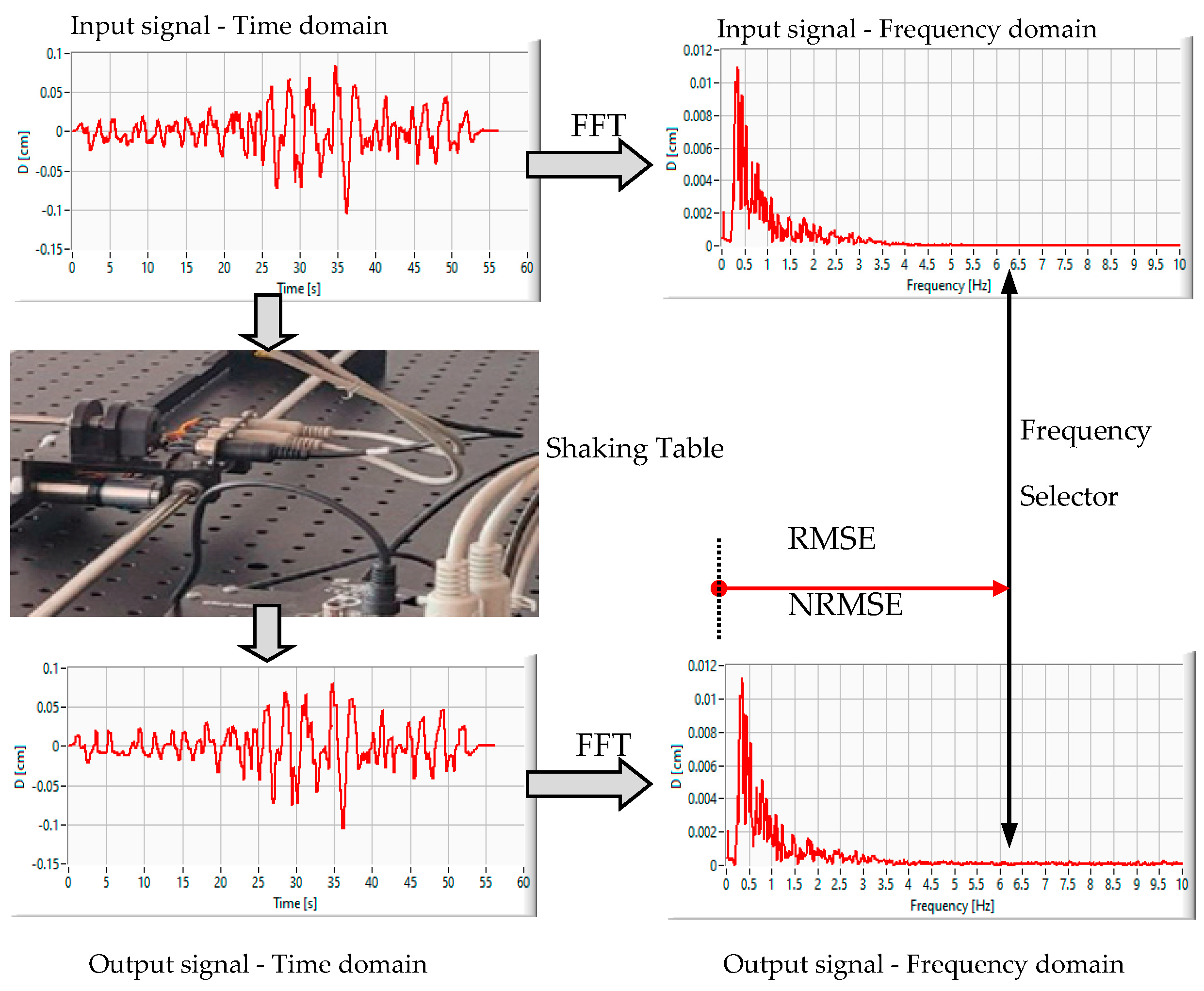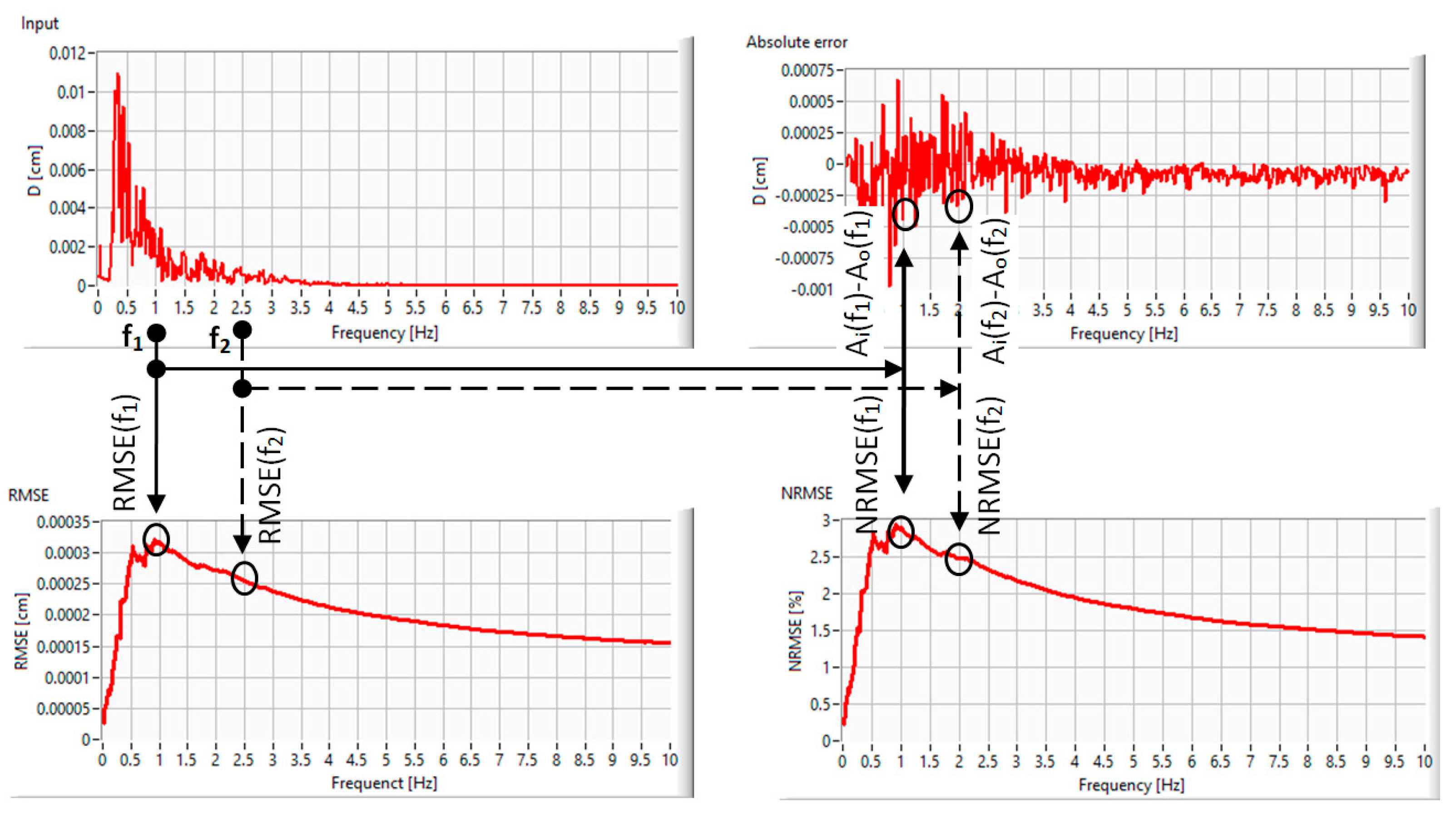Frequency Seismic Response for EEWS Testing on Uniaxial Shaking Table
Abstract
1. Introduction
2. Laboratory Small-Scale Shaking Table Design and Control
- -
- Mechanical part: (1) a standard steel plate, (2) a slide cart (linear rail system) with smooth surfaces to minimize the frictional resistance and auxiliary fixing elements.
- -
- Electrodynamic part: (3) an actuator able to drive the mechanical component (a DC micromotor and an optical encoder), supplied through a power amplifier (4).
- -
- Controlling part: computer with LabVIEW interface for generating input signals and (5) a data acquisition board through which command and data acquisition are executed.
3. Test Results
- -
- High enough magnitude because most of the EEWSs trigger the alarm at magnitudes higher than six;
- -
- Different enough spectral content because the simulator’s performances are evaluated in the frequency domain.
- Locally, for each individual frequency magnitude, in terms of magnitude absolute error.
- Globally, for the entire spectrum, in terms of root mean square error and normalized root mean square error, as to be compared with other reported results.
4. Discussion
- -
- Global RMSEs, computed for all spectral components to be compared with other reported results, have lower values than those reported in recent papers [39,40,41,42]. Even if simple control algorithms have been used, the minimization of the hardware arrangement, and the low weight of the moving parts (only 390 g for the cart and accelerometer), yields very good seismic-waveform-tracking characteristics. Additionally, the absence of some heavy actuators makes the pre-experimental phase very short, hence ensuring a high daily duty cycle.
- -
- For lower cutoff frequencies, both RMSE and NRMSE increase their values. The assessment of the prediction algorithm accuracy by using the standard (full frequency domain) RMSE can lead to unrealistic expectations.
5. Conclusions
Author Contributions
Funding
Data Availability Statement
Conflicts of Interest
References
- Kanamori, H.; Rivera, L. Energy partitioning during an earthquake. Geophys. Monogr. Ser. 2006, 170, 3–13. [Google Scholar]
- Sheibani, F.; Hager, B.H. Seismic Efficiency vs. Fracability; Effects of Mechanical Properties on Radiated Elastic Waves with Application to Hydraulic-Fracturing-Induced Microseismicity. In Proceedings of the AAPG Annual Convention and Exhibition, Houston, TX, USA, 5 April 2017. [Google Scholar]
- Beroza, G.C.; Kanamori, H. Earthquake seismology: An introduction and overview. In Reference Module in Earth Systems and Environmental Sciences. Treatise on Geophysics, 2nd ed.; Schubert, A., Ed.; Elsevier: Amsterdam, The Netherlands, 2015; Volume 4, pp. 1–50. [Google Scholar]
- Ji, C.; Archuleta, R.J.; Wang, Y. Variability of Spectral Estimates of Stress Drop Reconciled by Radiated Energy. Bull. Seismol. Soc. Am. 2022, 112, 1871–1885. [Google Scholar] [CrossRef]
- Das, R.; Joshi, S.; Meneses, C.; Biswas, T. Advanced Unified Earthquake Catalog for North East India. Appl. Sci. 2023, 13, 2812. [Google Scholar]
- Ammon, C.J.; Velasco, A.A.; Lay, T.; Wallace, T.C. Rupture directivity. In Foundations of Modern Global Seismology, 2nd ed.; Academic Press, Ed.; Elsevier: London, UK, 2020; pp. 496–497. [Google Scholar]
- Zhu, M.; Chen, F.; Zhou, W.; Lin, H.; Parcharidis, I.; Luo, J. Two-Dimensional InSAR Monitoring of the Co-and Post-Seismic Ground Deformation of the 2021 Mw 5.9 Arkalochori (Greece) Earthquake and Its Impact on the Deformations of the Heraklion City Wall Relic. Remote Sens. 2022, 14, 5212. [Google Scholar] [CrossRef]
- Freddi, F.; Galasso, C.; Cremen, G.; Dall’Asta, A.; Di Sarno, L.; Giaralis, A.; Woo, G. Innovations in earthquake risk reduction for resilience: Recent advances and challenges. Int. J. Disaster Risk Reduct. 2021, 60, 102267. [Google Scholar] [CrossRef]
- Ruggieri, S.; Calò, M.; Cardellicchio, A.; Uva, G. Analytical-mechanical based framework for seismic overall fragility analysis of existing RC buildings in town compartments. Bull. Earthq. Eng. 2022, 20, 8179–8216. [Google Scholar] [CrossRef]
- Ruggieri, S.; Vukobratović, V. Acceleration demands in single-storey RC buildings with flexible diaphragms. Eng. Struct. 2023, 275, 115276. [Google Scholar] [CrossRef]
- Koren, D.; Rus, K. The Potential of Open Space for Enhancing Urban Seismic Resilience: A literature Review. Sustainability 2019, 11, 5942. [Google Scholar] [CrossRef]
- Esposito, M.; Palma, L.; Belli, A.; Sabbatini, L.; Pierleoni, P. Recent Advances in Internet of Things Solutions for Early Warning Systems: A Review. Sensors 2022, 22, 2124. [Google Scholar] [CrossRef]
- Khan, I.; Kwon, Y.W. P-Detector: Real-Time P-Wave Detection in a Seismic Waveform Recorded on a Low-Cost MEMS Accelerometer Using Deep Learning. IEEE Geosci. Remote Sens. Lett. 2022, 19, 3006305. [Google Scholar] [CrossRef]
- Kuyuk, H.S.; Susumu, O. Real-time classification of earthquake using deep learning. Procedia Comput. Sci. 2018, 140, 298–305. [Google Scholar] [CrossRef]
- Prasanna, R.; Chandrakumar, C.; Nandana, R.; Holden, C.; Punchihewa, A.; Becker, J.S.; Jeong, S.; Liyanage, N.; Ravishan, D.; Sampath, R.; et al. “Saving Precious Seconds”—A Novel Approach to Implementing a Low-Cost Earthquake Early Warning System with Node-Level Detection and Alert Generation. Informatics 2022, 9, 25. [Google Scholar] [CrossRef]
- Allen, R.M.; Melgar, D. Earthquake Early Warning: Advances, Scientific Challenges, and Societal Needs. Annu. Rev. Earth Planet Sci. 2019, 47, 361–388. [Google Scholar] [CrossRef]
- Beltramone, L.; Gomes, R.C. Earthquake Early Warning Systems as an Asset Risk Management Tool. CivilEng 2021, 2, 120–133. [Google Scholar] [CrossRef]
- Havskov, J.; Alguacil, G. Seismic sensors. In Instrumentation in Earthquake Seismology. Modern Approaches in Geophysics; Havskov, J., Alguacil, G., Eds.; Springer: Dordrecht, The Netherlands, 2004; Volume 22, pp. 11–76. [Google Scholar]
- Choudhary, P.; Goel, N.; Saini, M. A Survey on Seismic Sensor based Target Detection, Localization, Identification, and Activity Recognition. ACM Comput. Surv. 2023, 55, 223. [Google Scholar] [CrossRef]
- Lellouch, A.; Biondi, B.L. Seismic Applications of Downhole DAS. Sensors 2021, 21, 2897. [Google Scholar] [CrossRef] [PubMed]
- Bogris, A.; Nikas, T.; Simos, C.; Simos, I.; Lentas, K.; Melis, Ν.S.; Chochliouros, I. Sensitive seismic sensors based on microwave frequency fiber interferometry in commercially deployed cables. Sci. Rep. 2022, 12, 14000. [Google Scholar] [CrossRef]
- Diaz, J.; Ruiz, M.; Udina, M. Monitoring storm evolution using a high-density seismic network. Sci. Rep. 2023, 13, 1853. [Google Scholar] [CrossRef]
- Saadia, B.; Fotopoulos, G. Characterizing Ambient Seismic Noise in an Urban Park Environment. Sensors 2023, 23, 2446. [Google Scholar] [CrossRef]
- Anthony, R.E.; Ringler, A.T.; Wilson, D.C.; Wolin, E. Do Low-Cost Seismographs Perform Well Enough for Your Network? An Overview of Laboratory Tests and Field Observations of the OSOP Raspberry Shake 4D. Seismol. Res. Lett. 2018, 90, 219–228. [Google Scholar] [CrossRef]
- Hussain, M.A.; Dutta, S.C.; Das, S. Effect of bidirectional ground shaking on structures in the elastic and post-elastic range: Adequacy of design provisions. J. Build. Eng. 2022, 45, 103656. [Google Scholar] [CrossRef]
- Mărmureanu, A. Rapid magnitude determination for Vrancea early warning system. Rom. J. Phys. 2009, 54, 965–971. [Google Scholar]
- Rinawi, A.M. Shaking Table-Structure Interaction. Ph.D. Thesis, University of California, Berkeley, CA, USA, 1991. [Google Scholar]
- Baran, T.; Tanrikulu, A.K.; Dundar, C.; Tanrikulu, A.H. Construction and performance test of a low-cost shake table. Exp. Tech. 2011, 35, 8–16. [Google Scholar] [CrossRef]
- Aldefae, A.H.; Shamkhi, M.S.; Khalaf, T. Design and manufacturing of geotechnical laboratory tools used in physical modeling. Cogent Eng. 2019, 6, 1637622. [Google Scholar] [CrossRef]
- Ozcelik, O.; Conte, J.P.; Luco, J.E. Comprehensive mechanics-based virtual model of NHERI@ UCSD shake table—Uniaxial configuration and bare table condition. Earthq. Eng. Struct. Dyn. 2021, 50, 3288–3310. [Google Scholar] [CrossRef]
- Gaetani, A.; Lourenço, P.B.; Monti, G.; Moroni, M. Shaking table tests and numerical analyses on a scaled dry-joint arch undergoing windowed sine pulses. Bull. Earthq. Eng. 2017, 15, 4939–4961. [Google Scholar] [CrossRef]
- Pagliaro, S.; Aloisio, A.; Alaggio, R.; Di Egidio, A. Rigid block coupled with a 2 dof system: Numerical and experimental investigation. Coupled Syst. Mech. 2020, 9, 539–562. [Google Scholar]
- Gao, C.; Yang, Y.; Wang, J. Development and application of a shaking table system. Arab. J. Geosci. 2022, 15, 1334. [Google Scholar] [CrossRef]
- El Hoseny, M.; Ma, J.; Josephine, M. Effect of Embedded Basement Stories on Seismic Response of Low-Rise Building Frames Considering SSI via Small Shaking Table Tests. Sustainability 2022, 14, 1275. [Google Scholar] [CrossRef]
- Damerji, H.; Yadav, S.; Sieffert, Y.; Debove, L.; Vieux-Champagne, F.; Malecot, Y. Design of a shake table with moderate cost. Exp. Tech. 2022, 46, 365–383. [Google Scholar] [CrossRef]
- O’hagan, J.; Ma, T.M.Q. Experimental assessment of PID control for a uniaxial shake table. In Proceedings of the 15th World Conference on Earthquake Engineering, Lisbon, Portugal, 24–28 September 2012. [Google Scholar]
- U.S. Geological Survey. Earthquake Hazards Program. Available online: https://earthquake.usgs.gov/monitoring/spectrograms/examples.php (accessed on 8 March 2023).
- Chai, T.; Draxler, R.R. Root mean square error (RMSE) or mean absolute error (MAE)?–Arguments against avoiding RMSE in the literature. Geosci. Model Dev. 2014, 7, 1247–1250. [Google Scholar] [CrossRef]
- Reyes, S.I.; Almazán, J.L.; Vassiliou, M.F.; Tapia, N.F.; Colombo, J.I.; de la Llera, J.C. Full-scale shaking table test and numerical modeling of a 3000-liter legged storage tank isolated with a vertical rocking isolation system. Earthq. Eng. Struct. Dyn. 2022, 51, 1563–1585. [Google Scholar] [CrossRef]
- Chen, P.C.; Lai, C.T.; Tsai, K.C. A control framework for uniaxial shaking tables considering tracking performance and system robustness. Struct. Health Monit. 2017, 24, e2015. [Google Scholar] [CrossRef]
- Yao, H.; Tan, P.; Yang, T.Y.; Zhou, F. Acceleration-based sliding mode hierarchical control algorithm for shake table tests. Earthq. Eng. Struct. Dyn. 2021, 50, 3670–3691. [Google Scholar] [CrossRef]
- Larbi, S.H.; Bourahla, N.; Benchoubane, H.; Choutri, K.; Badaoui, M. Earthquake ground motion matching on a small electric shaking table using a combined NN-pdff controller. Shock Vib. 2020, 2020, 7260590. [Google Scholar] [CrossRef]







| Earthquake Moment Magnitude (Mw) | Approximate Fault Length (km) | Maximum Epicentral Distance Where Earthquake Is Expected (km) | S Wave Arrival at Maximum Distance Where Earthquake Is Expected (s) | Potential Damage |
|---|---|---|---|---|
| 5 | 1 | 10 | 4 | insignificant |
| 5.9 | 6 | 40 | 10 | minor |
| 6 | 50 | 200 | 40 | moderate |
| 6.9 (crustal) | 400 | 700 | 200 | moderate to major |
| 7 (subduction) | 1000 | 1000 | 300 | major |
| No. | Name | Year | Station Name | Magnitude (Mw) | Rjb (km) | Rrup (km) | Sampling Period (s) |
|---|---|---|---|---|---|---|---|
| 1 | Chi-Chi_Taiwan-02 | 1999 | CHY065 | 5.9 | 125.26 | 125.89 | 0.005 |
| 2 | Chi-Chi_Taiwan-02 | 1999 | CHY067 | 5.9 | 126.39 | 126.56 | 0.004 |
| 3 | Chi-Chi_Taiwan-02 | 1999 | CHY071 | 5.9 | 122.02 | 122.19 | 0.005 |
| 4 | Parkfield-02_CA | 2004 | Hollister—Airport Bldg #3 | 6 | 121.51 | 121.54 | 0.005 |
| 5 | Parkfield-02_CA | 2004 | Salinas—County Hospital Gnds | 6 | 120.74 | 120.79 | 0.005 |
| 6 | Chi-Chi_Taiwan-03 | 1999 | ILA006 | 6.2 | 129.11 | 129.4 | 0.004 |
| 7 | Chi-Chi_Taiwan-03 | 1999 | ILA007 | 6.2 | 127.25 | 127.54 | 0.004 |
| 8 | San Fernando | 1971 | Isabella Dam (Aux Abut) | 6.61 | 130 | 130.98 | 0.005 |
| 9 | San Fernando | 1971 | Bakersfield—Harvey Aud | 6.61 | 111.88 | 113.02 | 0.005 |
| 10 | El Alamo | 1956 | El Centro Array #9 | 6.8 | 121 | 121.7 | 0.005 |
| 11 | Hector Mine | 1999 | Bombay Beach Fire Station | 7.13 | 120.69 | 120.69 | 0.005 |
| 12 | Lander | 1992 | Covina—W Badillo | 7.28 | 128.06 | 128.06 | 0.005 |
| Cutoff Frequency | RMSE (Cm) Min. | RMSE (cm) Max. | NRMSE (%) Min. | NRMSE (%) Max. |
|---|---|---|---|---|
| 3 Hz | 0.00021 | 0.00061 | 0.09 | 2.18 |
| 5 Hz | 0.00019 | 0.00047 | 0.058 | 1.75 |
| 7 Hz | 0.00017 | 0.00042 | 0.05 | 1.55 |
| 10 Hz | 0.00016 | 0.00038 | 0.044 | 1.48 |
Disclaimer/Publisher’s Note: The statements, opinions and data contained in all publications are solely those of the individual author(s) and contributor(s) and not of MDPI and/or the editor(s). MDPI and/or the editor(s) disclaim responsibility for any injury to people or property resulting from any ideas, methods, instructions or products referred to in the content. |
© 2023 by the authors. Licensee MDPI, Basel, Switzerland. This article is an open access article distributed under the terms and conditions of the Creative Commons Attribution (CC BY) license (https://creativecommons.org/licenses/by/4.0/).
Share and Cite
Donciu, C.; Serea, E.; Temneanu, M.C. Frequency Seismic Response for EEWS Testing on Uniaxial Shaking Table. Entropy 2023, 25, 655. https://doi.org/10.3390/e25040655
Donciu C, Serea E, Temneanu MC. Frequency Seismic Response for EEWS Testing on Uniaxial Shaking Table. Entropy. 2023; 25(4):655. https://doi.org/10.3390/e25040655
Chicago/Turabian StyleDonciu, Codrin, Elena Serea, and Marinel Costel Temneanu. 2023. "Frequency Seismic Response for EEWS Testing on Uniaxial Shaking Table" Entropy 25, no. 4: 655. https://doi.org/10.3390/e25040655
APA StyleDonciu, C., Serea, E., & Temneanu, M. C. (2023). Frequency Seismic Response for EEWS Testing on Uniaxial Shaking Table. Entropy, 25(4), 655. https://doi.org/10.3390/e25040655






